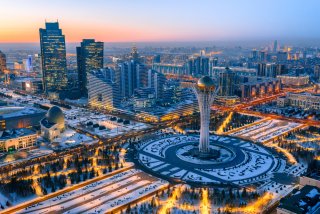Strong Kazakh National Identity Is an Asset for U.S. Strategy in Central Asia
Kazakhstan’s resilience to aggressive Russia and expansive China rises with the ethnic Kazakh population demographic boom.
As Moscow’s influence in Central Asia wanes due to the war in Ukraine, Washington has a historic opportunity to redefine and advance its strategic interests in the region.
Even before Russia’s second invasion of Ukraine began, Russian nationalists have routinely threatened northern Kazakhstan, which they call “southern Siberia,” with a Crimea-style annexation, as most of Kazakhstan’s ethnic Russians live there. In the 1950s, the Soviets moved millions of Russians to work on the virgin lands of the Kazakh steppes, making the Kazakhs a minority in their own country. After independence in 1991, the Kremlin used ethnic Russians in neighboring states to justify creating a “Russian World,” a neo-imperial concept designed to subvert sovereign nations.
However, the ethnic equilibrium in Kazakhstan has dramatically shifted since the 1990s. The economic policies pursued by Kazakhstan’s first president, Nursultan Nazarbayev, facilitated a demographic boom and cultural renaissance, which could prove the most important makers of the nation. The total population will reach twenty million this year, up from fifteen million just twenty years ago.
The country’s population is also becoming predominantly ethnic Kazakh. In fact, ethnic Russians no longer constitute a majority in any Kazakh province, even those along the border with Russia. Kazakhs now form over 70 percent of the total population, while the Russian share has shrunk to only 15 percent from 38 percent in 1989. Over the next decades, the ethnic Kazakh population will continue to rise, and the percentage of ethnic Russians fall.
The rise of Kazakh national identity is unique in the last two centuries, which were marked by the tragic history of Russian colonization, Soviet-induced famines (parallel to Ukraine’s Holodomor), forced sedentism that destroyed the traditional Kazakh nomadic culture, Stalin’s purges of national elites, and intense Russification.
The demographic rise of ethnic Kazakhs and their relocation to previously Russian-majority populated areas fundamentally changed the distribution of ethnic groups in the country. One stark example is Astana, where Nazarbayev moved the nation’s capital in 1997. The decision was political, affirming the north as an inseparable part of Kazakhstan and deterring any potential territorial claims by Moscow. Now Astana is a distinctly Kazakh city, with a young, dynamic population and hundreds of thousands of government employees required to maintain fluency in the Kazakh language. Nevertheless, the capital has also embraced the multicultural character of Kazakh society, with the Russian language still in use. The younger generation is rapidly learning English, which may soon become the second most-spoken language.
Pending alphabet changes will also have implications for the country’s geopolitical orientation. In 2017, former president Nazarbayev signed a decree mandating the Latinization of the Kazakh alphabet and replacing the Moscow-imposed Cyrillic script. The pending switch will solidify modern Kazakh identity and enhance links with Turkey, Europe, and the United States. Kazakh students in foreign universities also strengthen these ties. Over 90,000 young people are enrolled at higher education institutions abroad annually, often in the United States, Europe, South Korea, and Japan. Many study abroad through the state-funded Bolashak scholarship program.
This young generation already has an immense impact on Kazakhstan’s finance, engineering, technology, and healthcare sectors. Many serve in leadership positions in government and business, pursuing political and economic reforms announced by President Kassym-Jomart Tokayev in 2022. The level of advanced education is an invaluable asset for economic development and foreign investors. Kazakhstan is a notable energy exporter, the largest uranium producer in the world, and a rising rare earth minerals supplier in a market still dominated by China. The country is also critical for developing the Middle Corridor as an alternative energy, food, and fertilizer transit route through the Caspian Sea and the Caucasus. The Middle Corridor has grown in importance since Russia’s war in Ukraine and subsequent Western sanctions disrupted regional supply chains.
Kazakhstan has become particularly assertive during the past year, with the society and media pushing back against Russian threats and the government openly opposing Moscow’s annexation of Ukrainian territories. The Atameken TV channel recently broadcasted a map of lands historically inhabited by Kazakh tribes, including part of the Russian Federation. It was as much a response to frequent irredentist rhetoric by Moscow as it was a show of confidence in Kazakh national identity.
This rising national dignity undercuts Russia’s influence and inspires the largest Central Asian economy to pursue stronger strategic relations with the West. Weakening Russian influence in the region opens new opportunities for the United States to increase its engagement and limit China’s expansion into resource-rich Central Asia.
The United States, which has already invested $62 billion in Kazakhstan’s economy, can expand its presence in new economic projects. Investors can take advantage of the ongoing privatization of major state-owned companies, particularly in the mineral extraction sector, which is on the cusp of massive expansion. Congress could also unlock trade with Kazakhstan by revoking the Jackson-Vanik amendment, an archaic Cold War law that prevents granting permanent normal trade relations status to Kazakhstan and other Central Asian states. This will open new avenues for U.S. investment and trade with a growing independent nation at the heart of a strategic region.
Margarita Assenova is a senior fellow at the Jamestown Foundation. Her latest book with Janusz Bugajski is titled Eurasian Disunion: Russia’s Vulnerable Flanks.
Image: Shutterstock.

